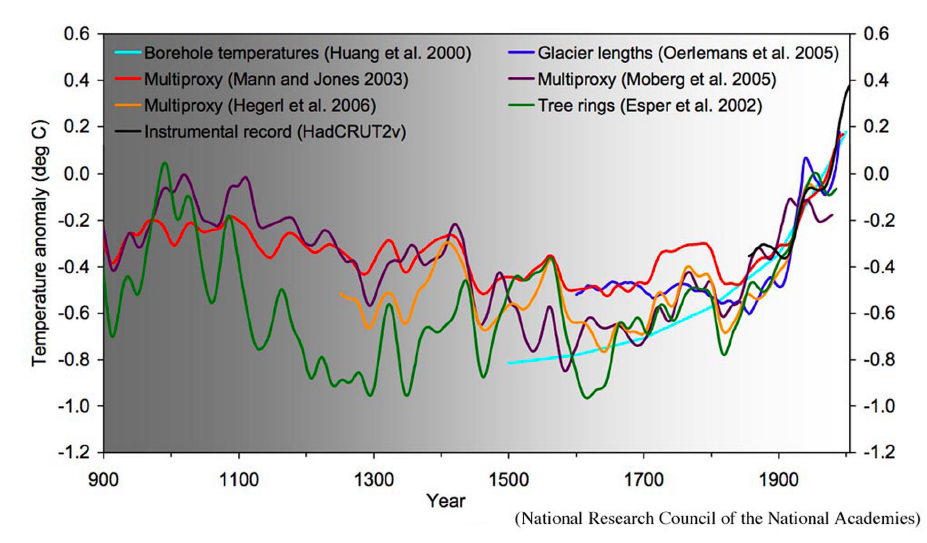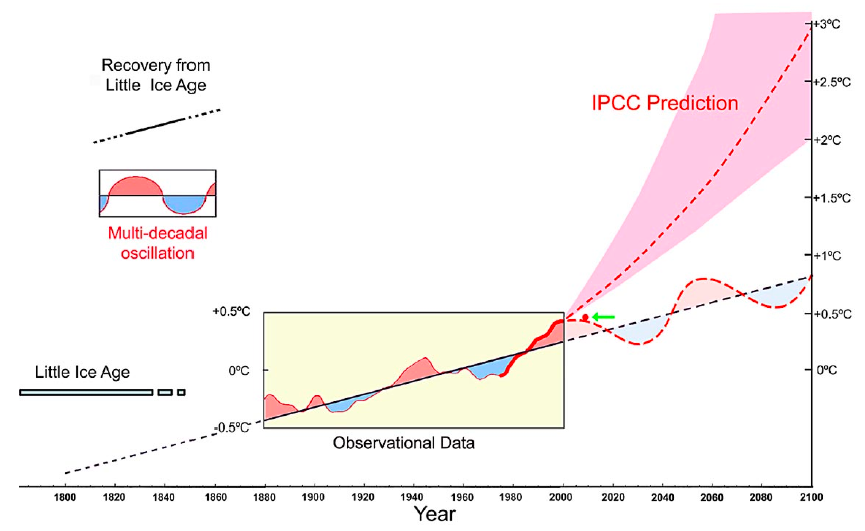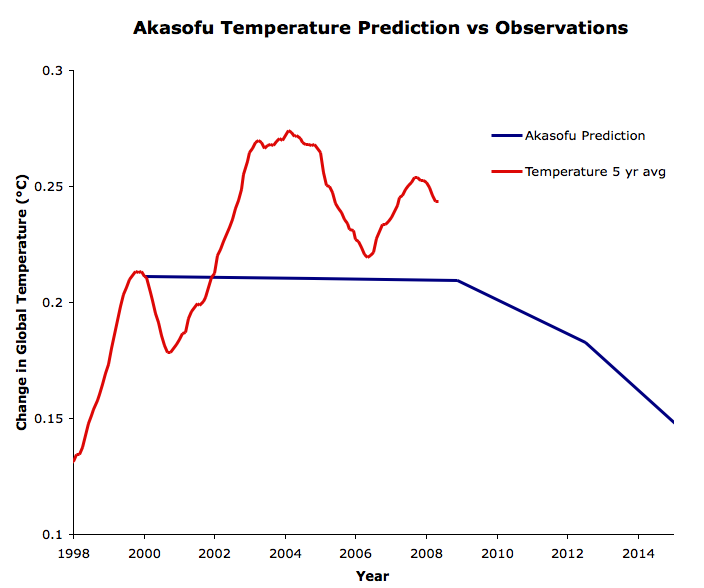Lessons from Past Climate Predictions: Syun-Ichi Akasofu
 In 2009, Syun-Ichi Akasofu (geophysicist and director of the International Arctic Research Center at the University of Alaska-Fairbanks) released a paper which argued that the recent global warming is due to two factors: natural recovery from the Little Ice Age (LIA), and "the multi-decadal oscillation". The paper was trimmed down and published in 2010 by a new journal called Natural Science, which is published by Scientific Research Publishing, which has been called "what may be the world’s strangest collection of academic journals." Most of the following discussion focuses on the unpublished version of the paper.
In 2009, Syun-Ichi Akasofu (geophysicist and director of the International Arctic Research Center at the University of Alaska-Fairbanks) released a paper which argued that the recent global warming is due to two factors: natural recovery from the Little Ice Age (LIA), and "the multi-decadal oscillation". The paper was trimmed down and published in 2010 by a new journal called Natural Science, which is published by Scientific Research Publishing, which has been called "what may be the world’s strangest collection of academic journals." Most of the following discussion focuses on the unpublished version of the paper.
Akasofu argues that the current warming trend of approximately 0.5°C per century actually began in the early 1800s, and that:
"This trend (0.5°C/100 years) should be subtracted from the temperature data during the last 100 years when estimating the manmade contribution to the present global warming trend. As a result, there is a possibility that only a small fraction of the present warming trend is attributable to the greenhouse effect resulting from human activities."
He also argues that the "multi-decadal oscillation" can explain some of the warming over the past 35 years:
"This particular natural change had a positive rate of change of about 0.15°C/10 years from about 1975 (positive from 1910 to 1940, negative from 1940 to 1975), and is thought by the IPCC to be a sure sign of the greenhouse effect of CO2. However, the positive trend from 1975 has stopped after 2000. One possibility of the halting is that after reaching a peak in 2000, the multi-decadal oscillation has begun to overwhelm the linear increase, causing the IPCC prediction to fail as early as the first decade of the 21st century."
Akasofu presents his argument graphically (Figure 1). Basically he argues that there is a linear warming trend caused by "recovery from the LIA", with natural oscillations superimposed upon it.

Figure 1: Akasofu's interpretation of the global warming trend and causes since 1880
In order for this to be a physically sound argument, Akasofu must explain the physical mechanism behind the "LIA recovery", and why this 0.5°C global warming trend continues to persist. What is the underlying cause? Surely a geophysicist will examine this question.
Akasofu's Physical and Logical Failure
Unfortunately, nowhere in the 55 pages of his unpublished paper does Akasofu examine the physical cause of his purported 0.5°C per century warming trend since 1825. Most of the paper is spent looking at various regional temperature proxies, as well as ice data, to show that the purported warming trend exists.
"Obviously, the LIA was caused by a natural change or changes. Further, the fact that an almost linear change of the temperature rise had been progressing until 2000 suggests that the linear change is a natural change, because the rapid increase of CO2 began only after 1946 (Figure 2c). The linear change began from 1800~1850, at least one hundred years before the rapid increase of CO2 in the atmosphere."
In the published version, Akasofu devotes a section to a discussion about galactic cosmic rays, but does not attempt to quantify their effect. In fact he begins the section by stating:
"It is not the purpose of this section to discuss any major causes of climate change."
Well that's a relief, I was afraid he was going to sneak some science in there! Instead, Akasofu appears to assume that the planet will naturally revert back to its previous state after a significant climate change as in the LIA. However, Rea et al. (2010) found that the climate does not behave in this manner:
"we present a new way of looking at long memory in these reconstructions and proxies, which gives support to them being described by the non-stationary models. The implications for climatic change are that the temperature time series are not mean reverting. There is no evidence to support the idea that the observed rise in global temperatures are a natural fluctuation which will reverse in the near future."
Not only does Akasofu fail to examine the physical causes of the warming since 1825, but he also fails to consider the possibility that a number of different factors are at play. For example, increased solar activity and low volcanic activity (and even human greenhouse gas emissions) contributed to the early 20th Century warming, but solar and volcanic activity have not contributed significantly to the warming since the mid-20th Century. It is a logical failure to assume that a warming over nearly two centuries must have the same physical cause throughout the 200 years, and this argument is contradicted by the observational data (i.e. increasing solar activity in the early 1900s, but no increase since mid-century).
Unsupported Linear Warming Assumption
A further failure of Akasofu's analysis is that while the linear warming trend over the past two centuries is approximately 0.5°C per century, nearly all of that warming has occurred over the past 100 years, as Akasofu's own Figure 7a shows (Figure 2).

Figure 2: Various temperature reconstructions in Akasofu Figure 7a, showing that most of the temperature increase over the past 200 years has occurred since 1900.
Akasofu also fails to justify his assumption of a linear warming trend over the past two centuries. A slight warming in the 1800s, followed by faster warming in the early 1900s, followed by even faster warming over the past few decades - sounds rather like an exponential trend, doesn't it? If you're going to fit a certain trend to the data, you first need a physical justification - what's the cause? Akasofu does not have this justification, and without a physical reason the choice of trend is essentially arbitrary.
Indeed, in a previous post, Riccardo fitted various trends to the global temperature data (Figure 3), and found that whether the residuals form a clear cycle depends on the choice of trend. In fact, the residual is more cyclical for an n=2 exponentlal fit than a linear fit (Figure 4). Therefore, Akasofu's argument for fitting the data with a trend plus multi-decadal oscillations makes more sense for an exponential trend.

Figure 3: HadCRUT3 monthly data (grey) and the fits for n=1 (red), 2 (green) and 4 (blue).

Figure 4: Residuals calculated with the Figure 3 trend curves shown with n=1 (red), 2 (green) and 4 (blue).
Thus we find that Akasofu's entire premise is faulty on many different levels: physical, logical, and statistical.
Natural Variability
Akasofu does finally address the issue of physical causality later in his paper, when he states that the multi-decadal oscillations such as the Pacific Decadal Oscillation (PDO) can explain the acceleration in global warming from approximately 1977 to 2000. While it's true that a positive PDO can explain some of the warming of surface temperatures, PDO and natural variability cannot explain either the ocean warming at the same time, or the long-term warming trend, whose cause Akasofu has still failed to address.
Akasofu's Prediction
Considering that Akasofu's paper almost entirely neglects physics and fails to address the causes of the observed warming trends, one might expect very little accuracy in his predictions of future temperature changes. However, although he does not explain its cause, Akasofu does assume that the 0.5°C per century warming trend discussed in his paper will continue into the future. So if the anthropogenic + natural warming trend is limited to 0.05°C per decade, Akasofu will have stumbled onto a correct prediction (Figure 5).

Figure 5: Akasofu vs. IPCC global temperature predictions
In order to evaluate the accuracy of Akasofu's prediction so far, we digitized Figure 5 and compared it to the Wood for Trees Index, which is a composite of the global temperature datasets compiled by NASA GISS, HadCRU, UAH, and RSS (Figure 6).

Figure 6: Akasofu's prediction from 2000 to 2015 (blue) vs. the Wood for Trees Index five year running average (red).
Akasofu's Results
As you can see, Akasofu predicted a very slight cooling (approximately 0.02°C) between 2000 and 2011, whereas the Wood for Trees Index has warmed approximately 0.1°C over that period. So his prediction has not been terribly inaccurate yet - there hasn't really been sufficient time to evaluate its accuracy.
However, given the expected atmospheric CO2 increase over the next century, in order for Akasofu's predicted 0.05°C per decade warming trend to hold true, climate sensitivity would have to be in the range of 0.5 to 1.5°C for doubled CO2, depending on how rapidly CO2 continues to increase. Coincidentally, this is approximately the same low climate sensitivty range that his fellow "skeptics" like Spencer, Lindzen, and Christy argue is accurate.
However, it's also important to note that as in Don Easterbrook's temperature predictions, Akasofu has completely ignored the warming effects of increasing atmospheric CO2 in his predictions, assuming that whatever caused the pre-industrial warming is also causing the current warming. Thus Akasofu is really arguing that the climate sensitivity to CO2 is effectively zero, and that the observed and projected warming is due to some other 'natural' effect which he has not identified, but describes as "LIA recovery". This is not a physical argument; Akasofu implies that extra heating from CO2 (which we've directly measured with satellites) isn't causing any warming - the heat somehow magically disappears. So even if his fellow "skeptics" are somehow correct about low climate sensitivity and Akasofu's prediction turns out to be accurate, it will simply be due to sheer luck.
Any temperature prediction like Easterbrook's and Akasofu's which totally ignores the warming effects of CO2 is fundamentally physically incorrect. Akasofu assumed a linear trend of unknown cause, an unknown periodic variability, and assumed that these two unknown phenomena will continue in the future, while disregarding what we know about the physics of the climate system. Unfortunately there's no knowledge to be gained from Akasofu's paper, except how not to predict future climate change.
NOTE: As you can see at the top right corner of this post, John Cook has created a snazzy new button for the Lessons from Past Climate Predictions series. We have also added some older posts which analyzed climate predictions, which you can see if you click on the button.
Posted by dana1981 on Thursday, 7 July, 2011
 In 2009, Syun-Ichi Akasofu (geophysicist and director of the International Arctic Research Center at the University of Alaska-Fairbanks) released a paper which argued that the recent global warming is due to two factors: natural recovery from the Little Ice Age (LIA), and "the multi-decadal oscillation". The paper was trimmed down and published in 2010 by a new journal called Natural Science, which is published by Scientific Research Publishing, which has been called "what may be the world’s strangest collection of academic journals." Most of the following discussion focuses on the unpublished version of the paper.
In 2009, Syun-Ichi Akasofu (geophysicist and director of the International Arctic Research Center at the University of Alaska-Fairbanks) released a paper which argued that the recent global warming is due to two factors: natural recovery from the Little Ice Age (LIA), and "the multi-decadal oscillation". The paper was trimmed down and published in 2010 by a new journal called Natural Science, which is published by Scientific Research Publishing, which has been called "what may be the world’s strangest collection of academic journals." Most of the following discussion focuses on the unpublished version of the paper.






